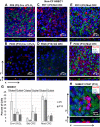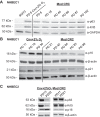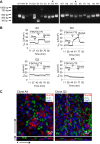Long-term culture and cloning of primary human bronchial basal cells that maintain multipotent differentiation capacity and CFTR channel function
- PMID: 29722564
- PMCID: PMC6139663
- DOI: 10.1152/ajplung.00355.2017
Long-term culture and cloning of primary human bronchial basal cells that maintain multipotent differentiation capacity and CFTR channel function
Abstract
While primary cystic fibrosis (CF) and non-CF human bronchial epithelial basal cells (HBECs) accurately represent in vivo phenotypes, one barrier to their wider use has been a limited ability to clone and expand cells in sufficient numbers to produce rare genotypes using genome-editing tools. Recently, conditional reprogramming of cells (CRC) with a Rho-associated protein kinase (ROCK) inhibitor and culture on an irradiated fibroblast feeder layer resulted in extension of the life span of HBECs, but differentiation capacity and CF transmembrane conductance regulator (CFTR) function decreased as a function of passage. This report details modifications to the standard HBEC CRC protocol (Mod CRC), including the use of bronchial epithelial cell growth medium, instead of F medium, and 2% O2, instead of 21% O2, that extend HBEC life span while preserving multipotent differentiation capacity and CFTR function. Critically, Mod CRC conditions support clonal growth of primary HBECs from a single cell, and the resulting clonal HBEC population maintains multipotent differentiation capacity, including CFTR function, permitting gene editing of these cells. As a proof-of-concept, CRISPR/Cas9 genome editing and cloning were used to introduce insertions/deletions in CFTR exon 11. Mod CRC conditions overcome many barriers to the expanded use of HBECs for basic research and drug screens. Importantly, Mod CRC conditions support the creation of isogenic cell lines in which CFTR is mutant or wild-type in the same genetic background with no history of CF to enable determination of the primary defects of mutant CFTR.
Keywords: CRISPR; ROCK inhibitor; conditional reprogramming; cystic fibrosis; human bronchial epithelial cells.
Figures









Similar articles
-
Assessing Human Airway Epithelial Progenitor Cells for Cystic Fibrosis Cell Therapy.Am J Respir Cell Mol Biol. 2020 Sep;63(3):374-385. doi: 10.1165/rcmb.2019-0384OC. Am J Respir Cell Mol Biol. 2020. PMID: 32437238 Free PMC article.
-
In vitro 3D culture lung model from expanded primary cystic fibrosis human airway cells.J Cyst Fibros. 2020 Sep;19(5):752-761. doi: 10.1016/j.jcf.2020.05.007. Epub 2020 Jun 18. J Cyst Fibros. 2020. PMID: 32565193 Free PMC article.
-
Pharmacological Rescue of Conditionally Reprogrammed Cystic Fibrosis Bronchial Epithelial Cells.Am J Respir Cell Mol Biol. 2017 May;56(5):568-574. doi: 10.1165/rcmb.2016-0276MA. Am J Respir Cell Mol Biol. 2017. PMID: 27983869 Free PMC article.
-
Correction of Airway Stem Cells: Genome Editing Approaches for the Treatment of Cystic Fibrosis.Hum Gene Ther. 2020 Sep;31(17-18):956-972. doi: 10.1089/hum.2020.160. Epub 2020 Sep 8. Hum Gene Ther. 2020. PMID: 32741223 Free PMC article. Review.
-
Personalized medicine in CF: from modulator development to therapy for cystic fibrosis patients with rare CFTR mutations.Am J Physiol Lung Cell Mol Physiol. 2018 Apr 1;314(4):L529-L543. doi: 10.1152/ajplung.00465.2017. Epub 2017 Dec 14. Am J Physiol Lung Cell Mol Physiol. 2018. PMID: 29351449 Free PMC article. Review.
Cited by
-
Assessing Human Airway Epithelial Progenitor Cells for Cystic Fibrosis Cell Therapy.Am J Respir Cell Mol Biol. 2020 Sep;63(3):374-385. doi: 10.1165/rcmb.2019-0384OC. Am J Respir Cell Mol Biol. 2020. PMID: 32437238 Free PMC article.
-
Influenza-mediated reduction of lung epithelial ion channel activity leads to dysregulated pulmonary fluid homeostasis.JCI Insight. 2018 Oct 18;3(20):e123467. doi: 10.1172/jci.insight.123467. JCI Insight. 2018. PMID: 30333319 Free PMC article.
-
Serially passaged, conditionally reprogrammed nasal epithelial cells as a model to study epithelial functions and SARS-CoV-2 infection.Am J Physiol Cell Physiol. 2022 Apr 1;322(4):C591-C604. doi: 10.1152/ajpcell.00363.2021. Epub 2022 Feb 23. Am J Physiol Cell Physiol. 2022. PMID: 35196166 Free PMC article.
-
DNA damage response at telomeres boosts the transcription of SARS-CoV-2 receptor ACE2 during aging.EMBO Rep. 2022 Feb 3;23(2):e53658. doi: 10.15252/embr.202153658. Epub 2021 Dec 2. EMBO Rep. 2022. PMID: 34854526 Free PMC article.
-
Molecular and Functional Characteristics of Airway Epithelium under Chronic Hypoxia.Int J Mol Sci. 2023 Mar 30;24(7):6475. doi: 10.3390/ijms24076475. Int J Mol Sci. 2023. PMID: 37047450 Free PMC article.
References
-
- Boat TF, Welsh MJ, Beaudet AL. Cystic Fibrosis. New York: McGraw-Hill, 1989.
-
- Crane AM, Kramer P, Bui JH, Chung WJ, Li XS, Gonzalez-Garay ML, Hawkins F, Liao W, Mora D, Choi S, Wang J, Sun HC, Paschon DE, Guschin DY, Gregory PD, Kotton DN, Holmes MC, Sorscher EJ, Davis BR. Targeted correction and restored function of the CFTR gene in cystic fibrosis induced pluripotent stem cells. Stem Cell Reports 4: 569–577, 2015. doi:10.1016/j.stemcr.2015.02.005. - DOI - PMC - PubMed
Publication types
MeSH terms
Substances
Grants and funding
LinkOut - more resources
Full Text Sources
Other Literature Sources
Medical
Research Materials

